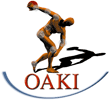Ορθοπαιδικό Αθλητιατρικό Κέντρο Ιωαννίνων
“Ένα σύγχρονο και πλήρως εξοπλισμένο εργαστήριο”
Surgical treatment of multiple knee ligament injuries in 44 patients: 2-8 years follow-up results.
Knee Surg Sports Traumatol Arthrosc. 2006 Aug;14(8):739-49.
The purpose of the study was to evaluate the mid-term results of surgical treatment in different groups of patients with multiple knee ligament injuries. Review of our patients' records revealed that 48 acute and chronic patients were surgically treated for combined knee injury. Due to severe capsular damage in these injuries, open techniques were used. In our treatment protocol, avulsed ligaments and tears of the posterolateral and posteromedial corner were repaired if possible, whereas midsubstance tears of cruciate ligaments and chronic cases were reconstructed with autografts. Postoperatively, an accelerated program of rehabilitation was introduced, aiming to progressively mobilize the joint and improve muscle endurance. For the follow-up evaluation we designed a protocol composed of two parts. In the first part, anatomical lesions were recorded and in the second part, clinical evaluation was performed using the Lysholm score, the Tegner rating system, the IKDC evaluation form, and the KT1000. Student's t tests and chi-square tests were used for data analysis. Forty-eight patients (mean age 28.6+/-11.9 years; 41 males) were classified according to the specific anatomical structures involved. Group A included 12 anterior cruciate ligament (ACL) and medial structure injuries, group B included 11 ACL or posterior cruciate ligament (PCL) ruptures combined with posterolateral injuries, and group C consisted of 25 knee dislocations (ACL and PCL ruptures which might be combined with damage of the collateral ligaments). Thirty-eight patients were surgically treated during the acute phase and ten patients were treated chronically. Forty-four patients (91.6%) were followed up at a mean of 51.3+/-29.9 months. Average Lysholm score was 87+/-12.3; average Tegner score was 5.09+/-2.19 before accident and 4.34+/-2.12 in re-examination; IKDC score was A in 10 cases, B in 22, C in 6, and D in 6. The mean range of motion was 129.9 degrees +/-12.5 degrees . The average loss of extension and flexion were 1.6 degrees +/-2.5 degrees and 7.6 degrees +/-7.9 degrees , respectively. The side-to-side difference in corrected anterior and posterior translation in quadriceps neutral angle and in anterior translation in 30 degrees angle was <3 mm for about 65% of our patients. Surgical treatment of multiple knee ligament injuries, using autografts, provided satisfactory stability, range of motion, and subjective functional results. However, despite the improvement of the quality of life, the preinjury patients' activity level was not fully obtained in re-examination. Patients underwent surgical treatment during the acute phase had better scores in several points, but finally there was no statistical significance between acute and chronic patients. Moreover, no statistically significant differences were observed among the groups with specific damaged anatomical structures.


